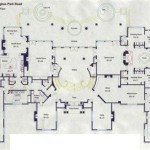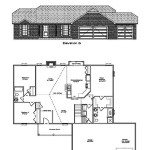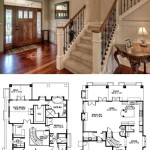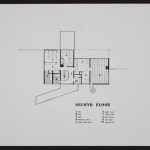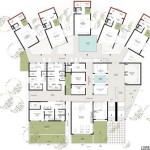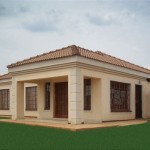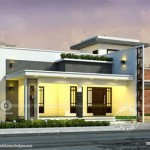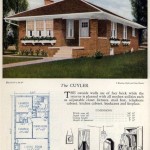Breezeway House Plans: Bridging Indoor and Outdoor Living
Breezeway house plans offer a unique architectural solution that gracefully connects two distinct living spaces, often the main house and a secondary structure like a guest house or garage. More than just a covered walkway, a breezeway enhances both functionality and aesthetics, creating a versatile area for relaxation, storage, or even additional living space.
Historically, breezeways served a practical purpose in warmer climates. Prior to widespread air conditioning, they provided essential ventilation, allowing air to flow freely between structures, thus cooling the home. Their open-air design encouraged cross-ventilation, capturing prevailing breezes and carrying away stagnant air and heat.
Modern breezeway house plans continue to offer climate control benefits, especially in regions with mild weather. They can reduce reliance on air conditioning by promoting natural ventilation and shading connected structures from direct sunlight. This can contribute to lower energy costs and a reduced environmental footprint.
Beyond their practical cooling function, breezeways contribute significantly to the overall aesthetic appeal of a home. They provide a visual break between structures, preventing a monolithic appearance and adding architectural interest. The design of the breezeway itself can be customized to complement the style of the main house, from rustic and traditional to sleek and modern.
The versatility of a breezeway extends its functionality beyond simply connecting structures. It can serve as a shaded outdoor living area, perfect for relaxing, entertaining, or enjoying meals al fresco. Furnishing a breezeway with comfortable seating, a dining table, or even an outdoor kitchen can create an inviting extension of the home's living space.
Storage is another practical application of breezeway designs. Built-in benches with storage compartments, shelving units, or even a dedicated storage closet can be incorporated into the breezeway structure, providing convenient storage for outdoor gear, gardening tools, or seasonal items.
In some breezeway house plans, the structure is enclosed to create additional living space. This can be a particularly attractive option for homeowners seeking a flexible area that can serve as a home office, studio, playroom, or guest suite. Enclosing a breezeway offers privacy and protection from the elements while still maintaining a sense of connection to the outdoors.
The architectural style of a breezeway can be tailored to complement the overall design of the home. Traditional breezeways often feature exposed beams, wood siding, and a pitched roof that echoes the main house. Contemporary designs might incorporate sleek lines, metal accents, and large glass panels to create a light and airy feel.
When considering breezeway house plans, careful attention should be given to the site orientation and prevailing winds to maximize the benefits of natural ventilation. Properly positioned, a breezeway can capture cooling breezes and direct them through the connected structures.
The materials used in the construction of a breezeway should be chosen for durability and weather resistance. Common materials include wood, brick, stone, and metal. The choice of materials will impact the overall aesthetic of the breezeway and its maintenance requirements.
Breezeway house plans offer a range of benefits, from improved ventilation and energy efficiency to enhanced aesthetics and expanded living space. Carefully considering the design and functionality of the breezeway allows homeowners to create a seamless transition between indoor and outdoor living, adding value and enjoyment to their homes.
The size and scale of the breezeway should be proportionate to the connected structures. A small breezeway might be sufficient to connect a main house to a detached garage, while a larger, more elaborate breezeway might be appropriate for connecting two larger structures, such as a main house and a guest house.
Privacy considerations are also important when designing a breezeway. If the breezeway is located in a highly visible area, incorporating features like screens, lattice panels, or strategically placed landscaping can enhance privacy while still allowing for airflow.
Lighting plays a key role in creating a welcoming and functional breezeway. Well-placed lighting can enhance the ambiance of the space in the evening and improve safety and security. Options include pendant lights, wall sconces, recessed lighting, and landscape lighting.
Incorporating ceiling fans into the breezeway design can further enhance ventilation and cooling, particularly in warmer climates. Ceiling fans circulate air, creating a gentle breeze and improving air circulation throughout the connected structures.
Ultimately, the best breezeway house plan will depend on the specific needs and preferences of the homeowner. By carefully considering the various design options and functionalities, individuals can create a breezeway that seamlessly integrates indoor and outdoor living, enhancing the comfort, value, and enjoyment of their home.

The Breezeway Floor Plans House On A Hill

Bungalow With Breezeway House Plans The Red Cottage

I Like The Breezeway Home Design Plans House Cabin

French Country Home Plan With Covered Breezeway

Bungalow With Den Like Breezeway 18243be Architectural Designs House Plans

Cottage House Plan With 4 Bedrooms And Breezeway 7981

150 Breezeway House Plans Ideas Design

Duplex Plan With Breezeway 3 Bdrm 1 451 Sq Ft Per Unit 153 2024

Craftsman House Plan With 3 Bedrooms And A Breezeway 3076

Barndominium Floor Plans With Breezeway 8 Creative Designs For Medium And Large Families

